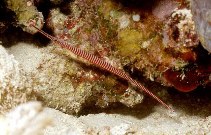| Family: |
Syngnathidae (Pipefishes and seahorses), subfamily: Nerophinae |
| Max. size: |
19 cm TL (male/unsexed) |
| Environment: |
reef-associated; marine; depth range 3 - 45 m |
| Distribution: |
Western Indian Ocean: Red Sea and Sodwana Bay, South Africa to the Chagos Islands and Maldives. |
| Diagnosis: |
Dorsal spines (total): 0-0; Dorsal soft rays (total): 20-23; Anal spines: 0-0; Anal soft rays: 4-4. Usually with 4-5 dark bands crossing opercle (Ref. 4281).
Description: Characterized by numerous alternating dark brown to reddish and pale (white to light grey) bands; caudal fin dusky red and white-edged; 10 caudal rays; rings 16 + 19 - 20; discontinuous superior trunk and tail ridges; inferior trunk ridge ends on anal ring; lateral trunk ridge confluent with inferior tail ridge; length of snout 1.4-1.7 in head length; depth of snout 10.4-15.6 in snout length; head length 3.6-4.7 in SL (Ref. 90102). |
| Biology: |
Common among coral and in reef caves and crevices; usually found in pairs. Nearly always seen swimming upside down against ceiling of caves (Ref. 48635). Ovoviviparous (Ref. 205). The male carries the eggs in a brood pouch which is found under the tail (Ref. 205). |
| IUCN Red List Status: |
Least Concern (LC); Date assessed: 09 May 2016 Ref. (130435)
|
| Threat to humans: |
harmless |
Source and more info: www.fishbase.org. For personal, classroom, and other internal use only. Not for publication.

